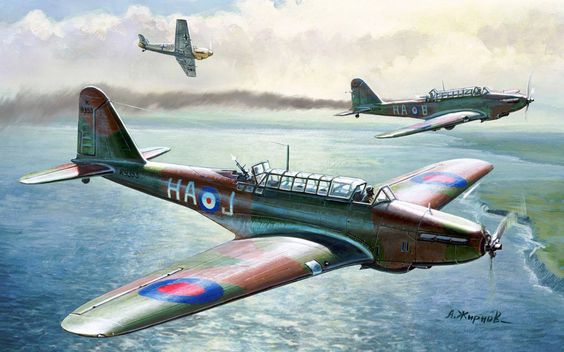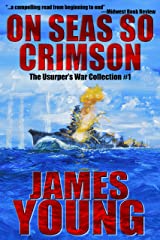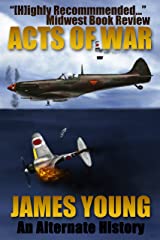“The Axis have won the toss and will kickoff.”—Aries, Head Referee, Great European Rematch, 1939-1945
Four things I’m going to assume with this blog post:
1.) You read the last blog post on aerial combat and liked it.
2.) Everyone involved possesses a general knowledge of World War II, is willing to go to the Wiki article on it or, is so highly motivated they think Antony Beevor‘s or Max Hastings’ single volume histories are a worthwhile afternoon killer. (Both are excellent. Harsh, but excellent.) So the apocryphal quote at the top of things hasn’t totally lost you.
3.) In this same vein World War II is, to quote a Prolific Trek catchphrase, “my jam.” So I might occasionally throw out references to people, places, and things without a hyperlink. Mea culpa in advance, but these blog posts (yeah, it’s going to be plural) will start looking like a Smurf infestation if I link every name I drop.
4.) Readers will realize that The Usurper’s War-series is fiction. Meaning that I played with some things there that may not have reflected the actual history. So when I start talking about “This didn’t happen until 1944…” and it’s something I made happen in 1943 in Acts of War or Collisions of the Damned…that’s why they call it alternate history.
Without further ado…
All That Passed Before
When last we left the aerial arena, people were flying around in biplanes blazing away at one another. The Allies had been preparing to unleash a massive aerial armada, the Germans were going to valiantly try to stop it, and the war was going to end in bloody street fighting burg by burg. Except…the Germans, their resolve weakened by the blockade and the realization that Americans apparently liked to make babies circa 1895-1900, tossed in the towel on 11 November 1918.
The war’s end had the perverse effect of flooding the market with aircraft. People who had no business driving, much less flying a plane, plunked down good money to go break their necks. Permissiveness was the rule of the day, and lots of people who had no business flying quickly found out Sir Isaac Newton holds veto power over all matters aeronautical. Despite the appalling death toll, however, this period meant aviation captured the imagination the world over, with everyone from daring barnstormers to famous aviatrices keeping the public’s collective eye skyward. Thus even in the midst of the Great Depression, people were still finding funds to press the proverbial envelope faster and higher. However, in no way was this progression universal nor necessarily embraced by military establishments.
Ergo, when Great European Rematch began in September 1939, combatants had both single seat, high speed monoplanes in their inventory…and poor bastards who were puttering around in the sky in biplanes. As in, if you flew fighters for the Royal Air Force or Fleet Air Arm, your war potentially started off with this beauty as you primary mount:
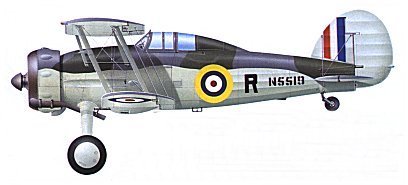
“Uh, excuse me, sir, but I think my father misplaced his plane…”
Meanwhile, the Germans, allegedly limited by the Versailles treaty, were licking their chops at the thought of facing Gloster Gladiators while tooling around in their brand new Bf-109s and Bf-110s. They say a picture is worth a 1000 words (coincidentally where we’re at right now), so I’ll just put the 109 and 110 up for comparison:
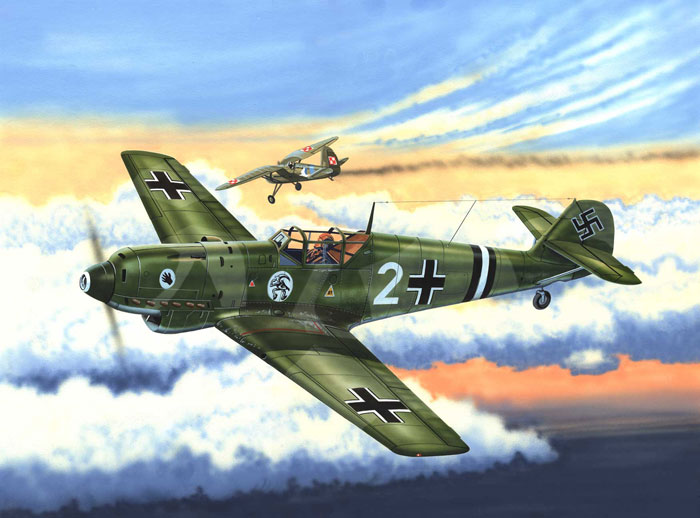
Bf-109

Bf-110
The Western Front 1940
Thankfully for many British pilots, the Germans went east (Poland) then north (Norway) before coming west. The Luftwaffe, having sent “volunteers” to fight in the Spanish Civil War in the mid-1930s, had learned some things. First, without having the ability to really have an air force thanks to the Treaty of Versailles, they largely skipped bomber barons stifling fighter development to the degree that Royal Air Force and United States Army Air Corps (later United States Army Air Force) did. Oh, don’t get me wrong–Herman Goering and Nazi hierarchy made Byzantine aircraft development into a way of life. Buuuuuuuttt, there was no Trenchard (RAF) or Arnold (USAAC / USAAF) actively sacrificing single engine fighter developmental programs that would have saved lives in favor of heavy bomber programs. (More on that in a later post…it’s not quite as much a jerk move as it sounds.)
This free fighter development and Spanish warm up match led to the Jagdflieger developing the four-aircraft flight (Schwarm) as the most flexible formation for combat. In this flight, you had two leaders (#1 and #3) and their wingmen (#2 and #4), with each leader / wingman combination known as a Rotte. Each leader could choose a target, with the wingman making sure no one showed up and disturbed the leader while he went about his killing. Given the high closing speeds brought about by the advances in air technology, the Germans discovered that this was the best blend between not having a bunch of yahoos throwing themselves around the sky and formations so rigid they were basically a squadron leader looking for stuff to kill and his eleven subordinates trying not to run into him.
*pause as the reader goes through that last paragraph again*
“What? No one would be so stupid as to fly around like tha…”
Ladies and gentlemen, I present to you the Royal Air Force. When the Germans turned west in May 1940, the standard Royal Air Force tactics were to fly around in squadron formation. These squadron formations, in turn, were divided into ‘vics’ of three. In practice, this was supposed to mean that the squadron technically had four groups by which to attack opposing bombers. Upon seeing the enemy, RAF squadron leaders were expected to call out a target, then a numbered attack. At this point, the vics would then proceed to attack said target in a proscribed, organized manner in sequence. Imagine a great waltz, except the orchestra is playing the “Death by Machine Gun, Aerial Movement” from the Spandau Ballet school of composition.

To be fair, in September 1939 this was a reasonable supposition. Fighters, at least to the RAF, were not supposed to be a primary concern. No one in the RAF had been informed that they’d be fighting in continental Europe (see part about Versailles Treaties, War to End All Wars, Appeasement, etc.) in the 1930s. Ergo, the good folks in Fighter Command drew a radius from Germany, looked at their own monoplanes’ performance, and said, “Well there’s no way the bloody Germans are getting their fighters here. At least, not more than once.” Thus, it was easy to see how the war could have been started still flying these formations, even with various individuals writing report after report about operations in Spain.
Still, by May 1940 the Germans’ methods should not have been totally a surprise. There were Polish pilots who had fled across Europe and were providing first hand testimony about how the Jagdwaffe just might know what it was about. British pilots had danced with their German counterparts during the so-called Phony War as well as in Norway prior to the storm breaking over France in May 1940. So perhaps even a circular or a “Hey chaps, the Germans tend to come in groups of four, with two of those four having every intent of collecting scalps. Might be time to throw out these stilted attack plans and get your heads on a swivel…” would have saved lives.
Instead, the RAF and their French counterparts got an aerial skull dragging. As in, most fights went pretty much like this clip from the miniseries “A Piece of Cake”:
[youtube https://www.youtube.com/watch?v=DbIthML-ExY?start=78&w=560&h=315]
Except, rather than Spitfires, the RAF was flying the slower Hurricane. Having been slow to make changes in the eight months of relative peace, a few weeks of penning “We’re sorry your son got blasted to kingdom come because his eyes were on his leader…” letters made some folks change their methods. They decided it was a good idea to put a “rover” up behind the squadron vic’s, with this position intended to give the rest of the squadron some warning that they were being stalked by approaching German fighters.
*momentary pause and cut to Jagdflieger laughing uncontrollably while discussing how they blew the “rover” out of the sky, then proceeded on down to flame a couple more of remaining British fighters*
So dangerous did this position become, there were documented cases of squadron commanders having to write up officers for “lack of moral fiber” and insubordination. Which is a polite way of saying that pilots were starting to tell squadron commanders where to get off, they weren’t serving as the flaming canary in the proverbial coal mine. As many Hurricane pilots found out, having an unsealed fuel tank in front of the cockpit could end very, very poorly when 109s were about. Listen to your buddy scream the whole 10-15,000 feet down, suddenly “I will see to it that you are transferred to the infantry…” doesn’t seem so threatening.
[youtube https://www.youtube.com/watch?v=tIZ53HjxVmk?start=2660&w=560&h=315]
From the German perspective, the Fall of France reinforced the Spanish Civil War’s lessons. The Schwarm had been validated as the base formation that allowed a squadron to put the maximum number of shooters forward. Almost as importantly, it allowed the maximum visual coverage of a given airspace, meaning that if everyone was doing their job it was very hard to surprise German fighters. The 109, even with its flaw such as poor landing characteristics, limited firepower, and short range, was proven to be more than capable to defeating anything it ran into. The 110, although not quite as effective as they had hoped, was also capable of conducting effective slashing attacks and escaping French and British fighters attempts to get it into a dogfight. Both fighters proved extremely capable bomber destroyers, with the British Fairey Battle and Blenheim along with everything in the French arsenal proving easy prey. As the German Army chased the British off the continent then proceeded to “march in the shade” when they got to Paris, the Jagdwaffe had achieved its primary mission of gaining then maintaining air superiority.
In some ways, the RAF got a blessing in disguise by just how quickly the Germans blitzkrieg rolled over the Allied ground forces. France fell so quickly and decisively that it took the Chamberlain government with it. Winston Churchill, being a much cold-blooded bastard than his predecessor, ignored French pleas to send the more advance Spitfire to try and retrieve the situation. As a result, the first time the Jagdflieger got a good look at the most advanced British fighter, it was over Dunkirk. Moreover, it was after Fighter Command had belatedly started telling squadron leaders “Hey, those numbered attacks? Maaaaayyyybeee not the best idea.” Being prewar officers rather than combat technicians, many of these leaders were loathe to change…but at least they’d been told. With the Luftwaffe now right across the Channel rather than well outside of fighter range, the crucible of combat would provide a lot more motivation for innovation.
What Changed, What Stayed the Same
1.) As noted in the last post, most kills were by surprise. Especially the poor bastards flying as rovers/weavers/sacrificial lambs. But even for the Germans, the cases where someone was not doing their job often led to a British Hurricane or French fighter getting their licks in and away before anyone knew what was coming.
2.) A big change was air combat’s speed. At the end of World War I, fighters topped out at 150 miles an hour. At the beginning of World War II, most fighters were either at or right around 300 miles per hour. Well, except for the Gladiators. *shudder* In any case, that dot on the windscreen turned into an angry fighter with its nose and wings twinkling much, much faster than it had in World War I. Conversely, this meant that combats took place over a much wider area. This could rapidly lead to what several pilots referred to as “empty sky syndrome,” i.e., a fight going from “Oh my God, we’re all gonna die in collisions…” to “Where the f__k did everyone go?” in a matter of seconds.
3.) Firepower relative to World War I made a massive increase. Not only did fighters now have to worry about bringing down heavily armored bombers, but the speed of combat meant a maneuvering target was only in the sights for a fleeting moment. More due to the first than the second, interwar designers had started hanging more and more machine guns on fighters (Britain) or switched to cannon / machine gun combinations (Germany). Whether it was the 8 x .303s (Spitfire / Hurricane) or 1 x 20mm / 2 x MGs (Germany) armament, World War II fighters opened the dance hitting way harder. Things would only get heavier as the war went on.
4.) Deflection shooting became a thing. This was not totally different than World War I. However, the amount of lead to blast someone crossing front to left at a relative velocity of 50-60 miles per hour is a whole different world than that of 300 mph. To quote German ace Hans-Joachim Marseille (who would later go on to fame in North Africa after the Battle of Britain)
“As long as I look into the muzzles, nothing can happen to me. Only if he pulls lead am I in danger.”
That’s right, if you were looking right into someone’s guns and your both in a turn, he couldn’t hit you. Or more correctly, if he was so close that he would be able to actually to hit without pulling the necessary lead, you needed to worry less about machine guns and more about the imminent collision. In some cases, pilots had to pull so much lead to account for the drop of their bullets that their target wasn’t even necessarily in sight beneath the nose of their aircraft. Although some services (e.g., the USN/USMC and Imperial Japanese Navy (IJN) had practiced this task as a course du jour, none of the European powers had given it much thought. Why? Bombers don’t maneuver (RAF) and the Jagdflieger generally assumed one either had it or they didn’t. By and large, the gunnery syllabi for these two services wouldn’t change much throughout the war.
5.) Despite heavier armament, most kills still happened at short range. This was partially a factor of the “never saw what hit him” as well as the lack of deflection training. How short is short? In ground combat, the average machine gun was capable of shooting out to 1000 meters, with most shooting taking place at 4-500 meters depending on line of sight. In the initial stages of World War II, the British set the convergence point of their guns, i.e. the point where all 8 streams should meet, at 300 meters…and found that people were just flat out missing targets at that range. With a few exceptions, most Experten (German aces) and their RAF counterparts found that shooting over 200 meters didn’t accomplish much other than warning your prey. This fact did not change even when engaging with 20mm cannon versus the British .303 machine guns.
6.) The bomber, contrary to what interwar pundits had speculated, did not “always get through.” In fact, beginning with the British daylight attack on Wilhelmshaven and going all the way until the French capitulated, bombers often took a mauling on both sides. Given the Germans achieved air superiority fairly on, this lesson didn’t quite have time to sink…okay, who am I kidding? Despite irrefutable evidence that bombers were vulnerable, everyone kept thinking unescorted bombing attacks had a chance. This…well, let’s just say this is going to become important next post.
Overall, fighter combat was largely taking up where it had left off in World War I, just faster, more lethal, and with new formations. The Schwarm was as revolutionary to the profession as the the forward pass was to North American football and was a large part of the reason Britain found itself alone. However, as will be shown in my next post, there was something to be said for playing a home versus away game when it came to vying for air superiority. Geography, in the form of the English Channel, was about to flip the script for the Jagdwaffe.
Three books for the masses:
The Story of Air Fighting by Johnnie Johnson
Me109 by Martin Caidin
Horrido by Trevor J. Constable and Raymond F. Toliver
One book for the monkhood:
Fighter Tactics and Strategy, 1914-1970 by Edward H. Sims As can be seen by the dates, this encompasses much more than the last two blog posts. But given the overwhelming number of books to choose from, I figured I’d slip this one in at this point.

